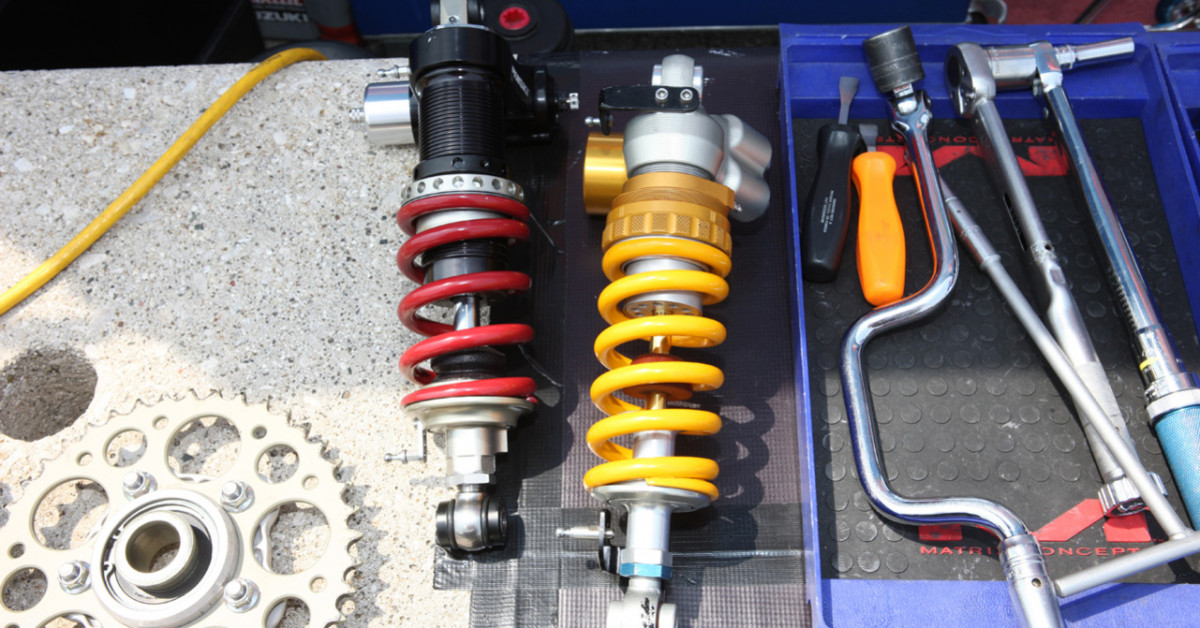
Tech Tuesday: Motorcycle Suspension
This week’s Tech Tuesday article is about the improving the suspension components on your motorcycle. Changing the suspension on your motorcycle is probably one of the simplest component changes that can be done, and give you the best bang for the buck. On average the first performance enhancing purchase a person makes on their new motorcycle is an exhaust or a fuel management system. The purchase of motorcycle suspension upgrades for the average street riders are the last thing on the upgrade list. A person that does track days or races occasionally knows that the suspension upgrades would put upgrading the suspension higher on the” to do” list, Why is that?
On average the motorcycles stock suspension is not bad, the materials that make up the suspension components are of good sound quality. The major problem with stock motorcycle suspension is its set up for a generic rider. The components inside the fork tubes and shocks are made to work for a generic setting for street. When the suspension is set correctly, it allows the motorcycle to gain or maintain traction by aiding the tires to maintain contact with the ground surface. This added traction is caused because the motorcycle has better ability to transfer weight, and better absorb upward and downward momentum when it needs to.
When a person wants to fine tune a motorcycle to better fit themselves for suspension upgrades, they will need to start by determining what kind of riding they will be doing, track days, racing, canyon carving, off road with dirt and jumps or just street riding. The riding style is important to which direction a person will need to start in setting up a good suspension setting base. The next step, once you’re riding style has been determined, will be to getting the correct spring’s rate for the weight of the rider. Motorcycle suspensions are designed so that the springs are always under compression, even when fully extended. Pre-load is used to adjust the initial position of the suspension with the weight of the motorcycle and rider acting on it.
Now that the spring rate is correct, the next step would be to properly adjust the sag of the suspension to properly allow the forks and shock to operate within the appropriate ranges. Total sag is the difference between the fully extended length of the suspension and the length compressed by the weight of the motorcycle and rider. Total sag is set to optimize the initial position of the suspension to avoid bottoming out or topping out under normal riding conditions. When the suspension bottoms out the suspension is compressed to the point where it mechanically will not compress any more. The opposite side is obviously topping out which occurs when the suspension extends fully and cannot extend any more.
Total sag can be adjusted by changing the air pressure inside the forks and shocks. Increasing pre-load inside the forks increases the initial force on the spring thereby reducing total sag. Decreasing pre-load decreases the initial force in the spring thereby increasing total sag. Valves at the top of the forks allow air to be added or released from the fork.
Inside of a fork tube or shock there is a Cartridge with various springs covering small openings that control the damping of the fork or shock. The springs lift with force to allow fluid to flow through the openings that intern restricts the flow of fluid to allow dampening. The cartridges in fork tubes can be changed to an aftermarket type that is manufactured with better engineering, to keep the external fork tubes of a motorcycle.
There are many manufactures that make suspension parts. Improving motorcycle performance to gain more horsepower is good to make a motorcycle go fast. Improving motorcycles suspension will in turn help a rider harness the extra horsepower that the riders are shooting for and make it a more reliable machine. Making horsepower is different to putting horsepower to the ground, therefore, suspension modifications help the rider feel more confident, while enabling the motorcycle plant the tires to the ground where needed.
Latest news































